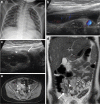Extracardiac imaging findings in COVID-19-associated multisystem inflammatory syndrome in children
- PMID: 33433671
- PMCID: PMC7801777
- DOI: 10.1007/s00247-020-04929-1
Extracardiac imaging findings in COVID-19-associated multisystem inflammatory syndrome in children
Abstract
Background: Coronavirus disease 2019 (COVID-19)-associated multisystem inflammatory syndrome in children (MIS-C) is an emerging syndrome that presents with a Kawasaki-like disease and multiorgan damage in children previously exposed to COVID-19.
Objective: To review the extracardiac radiologic findings of MIS-C in a group of children and young adults with a confirmed diagnosis of MIS-C.
Materials and methods: In a retrospective study from April 1, 2020, to July 31, 2020, we reviewed the imaging studies of 47 children and adolescents diagnosed with MIS-C, 25 females (53%) and 22 males (47%), with an average age of 8.4 years (range 1.3-20 years). Forty-five had chest radiographs, 8 had abdominal radiographs, 13 had abdominal US or MRI, 2 had neck US, and 4 had brain MRI.
Results: Thirty-seven of 45 (82%) patients with chest radiographs had findings, with pulmonary opacities being the most common finding (n=27, 60%), most often bilateral and diffuse, followed by peribronchial thickening (n=26, 58%). Eight patients had normal chest radiographs. On abdominal imaging, small-volume ascites was the most common finding (n=7, 54%). Other findings included right lower quadrant bowel wall thickening (n=3, 23%), gallbladder wall thickening (n=3, 23%), and cervical (n=2) or abdominal (n=2) lymphadenopathy. Of the four patients with brain MRI, one had bilateral parieto-occipital abnormalities and another papilledema.
Conclusion: The diagnosis of MIS-C and its distinction from other pathologies should be primarily based on clinical presentation and laboratory evidence of inflammation because imaging findings are nonspecific. However, it should be considered in the setting of bilateral diffuse pulmonary opacities, peribronchial thickening, right lower quadrant bowel inflammation or unexplained ascites in a child presenting with Kawasaki-like symptoms and a history of COVID-19 infection or recent COVID-19 exposure.
Keywords: Abdomen; Children; Coronavirus disease 2019; Lungs; Magnetic resonance imaging; Multisystem inflammatory syndrome in children; Radiography; Ultrasound.
Conflict of interest statement
None
Figures





Comment in
-
Imaging in support of the clinical diagnoses of COVID-19 and multisystem inflammatory syndrome in children.Pediatr Radiol. 2021 May;51(5):693-694. doi: 10.1007/s00247-021-04999-9. Epub 2021 Feb 17. Pediatr Radiol. 2021. PMID: 33595703 Free PMC article. No abstract available.
Similar articles
-
Imaging Findings in Multisystem Inflammatory Syndrome in Children (MIS-C) Associated With Coronavirus Disease (COVID-19).AJR Am J Roentgenol. 2021 Feb;216(2):507-517. doi: 10.2214/AJR.20.24032. Epub 2020 Jul 29. AJR Am J Roentgenol. 2021. PMID: 32755212
-
Multisystem inflammatory syndrome in children associated with SARS-CoV-2: extracardiac radiological findings.Br J Radiol. 2022 Jan 1;95(1129):20210570. doi: 10.1259/bjr.20210570. Br J Radiol. 2022. PMID: 34889647 Free PMC article.
-
Chest radiograph features of multisystem inflammatory syndrome in children (MIS-C) compared to pediatric COVID-19.Pediatr Radiol. 2021 Feb;51(2):231-238. doi: 10.1007/s00247-020-04921-9. Epub 2021 Jan 6. Pediatr Radiol. 2021. PMID: 33404786 Free PMC article.
-
The importance of heart and brain imaging in children and adolescents with Multisystem Inflammatory Syndrome in Children (MIS-C).Rheumatol Int. 2021 Jun;41(6):1037-1044. doi: 10.1007/s00296-021-04845-z. Epub 2021 Apr 17. Rheumatol Int. 2021. PMID: 33864498 Free PMC article. Review.
-
Imaging findings in acute pediatric coronavirus disease 2019 (COVID-19) pneumonia and multisystem inflammatory syndrome in children (MIS-C).Pediatr Radiol. 2022 Sep;52(10):1985-1997. doi: 10.1007/s00247-022-05393-9. Epub 2022 May 26. Pediatr Radiol. 2022. PMID: 35616701 Free PMC article. Review.
Cited by
-
Findings of Abdominal Imaging in Patients with COVID-19 - Part 1: Hollow Organs.Middle East J Dig Dis. 2022 Jul;14(3):278-286. doi: 10.34172/mejdd.2022.284. Epub 2022 Jul 30. Middle East J Dig Dis. 2022. PMID: 36619269 Free PMC article. Review.
-
Multisystem inflammatory syndrome in children and Kawasaki disease; comparison of their clinical findings and one-year follow-up-a cross-sectional study.Ital J Pediatr. 2023 Jul 21;49(1):90. doi: 10.1186/s13052-023-01489-6. Ital J Pediatr. 2023. PMID: 37475054 Free PMC article.
-
Review of COVID-19, part 1: Abdominal manifestations in adults and multisystem inflammatory syndrome in children.Clin Imaging. 2021 Dec;80:88-110. doi: 10.1016/j.clinimag.2021.06.025. Epub 2021 Jun 24. Clin Imaging. 2021. PMID: 34298343 Free PMC article. Review.
-
Abdominal US in Pediatric Inflammatory Multisystem Syndrome Associated with SARS-CoV-2 (PIMS-TS).Radiology. 2022 Apr;303(1):173-181. doi: 10.1148/radiol.211737. Epub 2021 Dec 7. Radiology. 2022. PMID: 34874199 Free PMC article.
-
Pediatric Radiology in Era of COVID-19, International Consensus and What Lies Beyond Pneumonia: A Review.JNMA J Nepal Med Assoc. 2021 Nov 15;59(243):1196-1203. doi: 10.31729/jnma.7122. JNMA J Nepal Med Assoc. 2021. PMID: 35199747 Free PMC article. Review.
References
-
- CDC Health Alert Network (2020) Multisystem inflammatory syndrome in children (MIS-C) associated with coronavirus disease 2019 (COVID-19). Centers for Disease Control and Prevention website. https://emergency.cdc.gov/han/2020/han00432.asp. Accessed 10 June 2020
-
- Royal College of Paediatrics and Child Health – Health Policy Team (2020) Guidance: paediatric multisystem inflammatory syndrome temporally associated with COVID-19 (PIMS). Royal College of Paediatrics and Child Health website. https://www.rcpch.ac.uk/resources/guidance-paediatric-multisystem-inflam.... Accessed 10 June 2020
-
- Capone C, Subramony A, Sweberg T, et al. Characteristics, cardiac involvement, and outcomes of multisystem inflammatory syndrome of childhood associated with severe acute respiratory syndrome coronavirus 2 infection. J Pediatr. 2020;224:141–145. doi: 10.1016/j.jpeds.2020.06.044. - DOI - PMC - PubMed
MeSH terms
Supplementary concepts
LinkOut - more resources
Full Text Sources
Other Literature Sources
Medical
Miscellaneous

